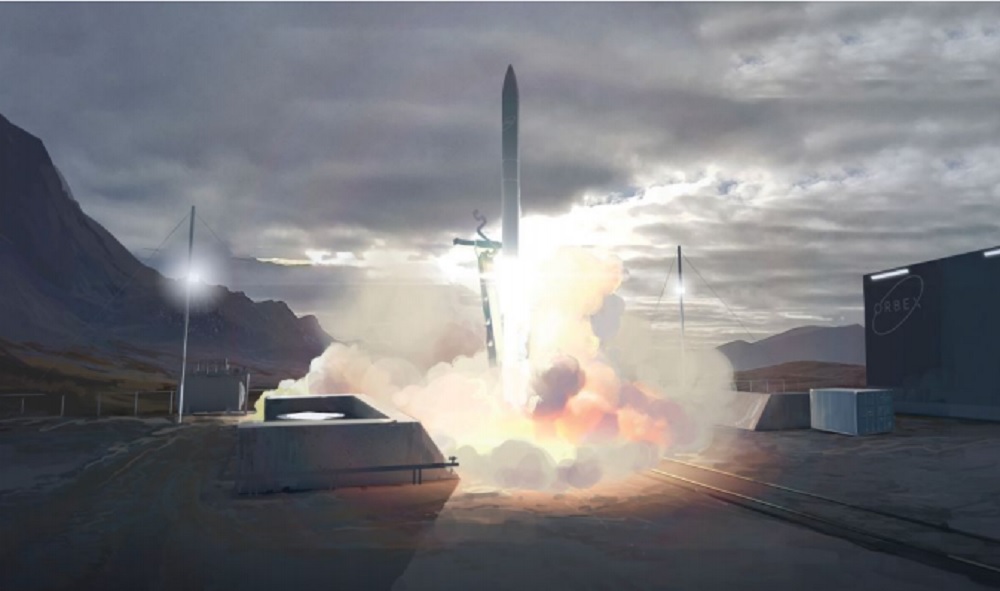The UK launch industry is awakening and setting targets - half a century after Black Arrow
- Transfer

After many efforts by the British government and many years of lobbying the interests of the space industry, the United Kingdom seems to be returning to the launch services market. Image source: original article
On October 28, 1971, the Black Arrow launch vehicle (“Black Arrow”) was launched from the Woomera test site in Australia; She successfully launched a small satellite called Prospero, designed to study the effects of outer space on orbiters. This was the first time in the history of Britain when she launched a payload on a rocket of her own design and construction; Alas, such an event was at the same time and the last like, so far.
After all, three months earlier, the government closed the Black Arrow program, but the launch still took place, since the RN had already been delivered to Australia. In fact, the UK was also the first country to acquire orbital launches only to abandon it immediately.
But now, after many efforts by the British government and many years of lobbying for the interests of the space industry, the United Kingdom seems to be returning to the launch services market. At the International Air Show in Farnborough, held in mid-July, officials made a number of statements, according to which they plan to restore the country's ability to take payload into space from launch pads in the state; however, the means of withdrawal, for the most part, will be third-party production.
Scottish spaceport

Black Arrow, UK's own design, starts from Woomera, Australia, 1971. Photo source: Wikipedia
The construction of a cosmodrome in Britain has been discussed for years. Basically, there were proposals to rebuild any of the existing facilities, such as a former military base or an underloaded civilian airport, into a launch pad for suborbital devices like the SpaceShipTwo from Virgin Galactic or for other systems with air launch. In 2015, the list of potential applicants for rework narrowed to six points.
However, since the focus of attention in the industry shifted to microsatellites and ultra-low RN, the strategy of the British government began to change in a natural way; and on July 15, it announced that instead of one candidate out of six a ground would be built from scratchvertical start in northern scotland .
“Alas, I had to keep some secrecy,” says Roy Kirk, project manager at Highlands and Islands Enterprise; This agency for the development of the Scottish economy has just received a state grant of $ 3.3 million to begin work on the construction of a space center on the A’Mhoine peninsula in the Sutherland region, on the northern coast of Scotland.
It is planned that from this point it will be possible to launch vertically small rockets with a trajectory to the north. “It’s just super, that with the new complex we just get access to where we are most striving, for example, to sun-synchronous orbitsor any others with a similarly high inclination, "explains Roy Kirk," but you do not need to build some kind of hulk. We need not something like a “rocket alley” at Cape Canaveral, but rather the opposite, like what Rocketlab has in New Zealand . ”
Kirk also added that in addition to the initial contribution from the government, Highlands and Islands Enterprise "secured the principal support" of investors for another $ 13 million needed to build basic infrastructure. In addition, coordination processes with environmental and other supervisory organizations regarding the construction of the cosmodrome have already begun, so that all the necessary documents are ready by 2020.
“Obtaining all the required permissions may not be so easy, and all contractors have set themselves the goal of securing support for the project from the public,” says Kirk. “According to the current work schedule, we seem to fit, but the planning process still faces many obstacles, without any doubt. We very much count on the approval of the local, as well as on the contribution of all those who participate in this large construction site. But who exactly and how seriously “for us” - only time will tell. ”
Removal vehicles

Orbex, a small startup from the UK, is developing an ultra-small launch vehicle called Prime, which is also expected to be used for launches from the space center in Scotland. Image source: Orbex
Despite the fact that the UK Space Agency (UK Space Agency) finally chose a place for the launch site, there was not a word about who would start with it. Only the next day, the public was presented with a list of companies that are willing to become operators, subject to additional state support.
Of course, one of them was Lockheed Martin, which received $ 31 million for organizing launches in Sutherland. This sum includes financing of the development of the upper stage called Small Launch Orbital Maneuvering Vehicle, which they promise to produceMoog , and the Kubsat-technology demonstrator from Orbital Micro Systems, which plans to deploy a whole constellation of such satellites for weather monitoring.
"The countdown to the first launch from the British land has begun," said Rick Ambrose, executive director of commercial space space at Lockheed Martin, at the Farnborough air show during a briefing on the space strategy of the United Kingdom.
The funniest thing here is that the representative of Lockheed Martin did not specify what exactly is starting “from the British land”, since the company does not have its own PH, and all that was shown at the presentation is a certain conventional “rocket”, completely painted black and carrying on board LM logo and Union Jack .
On questions about this, Patrick Wood, Regional Director for Space at Lockheed Martin, replied that "the most suitable and proven commercial launch vehicle, specifically designed for the output of small vehicles, will be in use. We’ll give you the details shortly. ”
In connection with such an answer, gossip began at once on a broad front that the “most suitable”, of course, would be the Electron PH from Rocket Lab, the company into which Lockheed invested back in 2015. However, LM officials refused to confirm such rumors, nevertheless speaking of Electron as a “preferred choice”.
Patrick Wood: “We work closely with Rocket Lab and know that their rocket is very good. But for now, we are closely watching them only as a strategic investor. ”
There are also questions to another government-selected company, Orbex, a small UK startup, developing an ultra-small launch vehicle called Prime, which is also supposed to be used for launches from the cosmodrome in Scotland. The startup has already received $ 7 million from UKSA for its development.
For some time, Orbex seemed to become invisible, but at Farnborough the company presented a large-scale exposition; In addition, it became known that Orbex managed to raise an additional $ 40 million through both government grants and private funding from European agencies.
Chris Larmoor, Orbex Executive Director: “Around the world, there are now a few dozen different projects of ultra-small launch vehicles, but only a few at the same time have quite competent technical specialists and acceptable material support; I think, given the fact that we were chosen for such a serious task, we are now also on this list. ”
The investment will help Orbex increase its staff from 15 employees to 40 or more by 2019; Now they are busy testing engines and modifying subsystems, and the first flight of the finished product should take place in 2021.
However, on the way to space from the Lockheed Martin site, Orbex will clearly have certain problems. Fuel for Prime is propane, while Electron has if it is the LM-kerosene that chooses it. Chris Larmour argues that part of the infrastructure can be shared, but two separate starts will be needed.
“In the next few months, we will have to settle such questions with all the participants in the program,” says Chris. “But we are not at all against cooperation if this benefits the common cause.”

Rick Ambrose, executive director for commercial space, Lockheed Martin, speaks with British Minister of Business, Energy and Industrial Strategy Greg Clark and other officials at the Farnborough International Air Show. Photo source: Lockheed Martin
Consolation prizes

An accelerating unit of Orbex Prime's launch vehicle brings the satellite into a given orbit, in the artist's view. Image source: Orbex
The government decision on Scotland is the loss of positions for airports, each of which has been lobbying its own candidacy for many years in the competition for the right to become a future spaceport. However, UKSA has organized an additional fund of $ 2.5 million to one of them, which “will provide a suitable business plan”.
And at the same airport, it seems, they think that there is a "suitable" one. Newquay Cornwall at the Farnborough Air Show signed an agreement with Virgin Orbit that could bring LauncherOne straight to the runway in south-west England.
Patrick McCall, managing director of the Virgin Group and a member of the board of directors of Virgin Orbit, believes that the idea of using Cornwall as a platform responds to customer requests: “Many people want to go into space, but these people are scattered around the planet. Since we have clients including here, we can make it easier for them to receive the service. In addition, from different points you can go to different orbits. "
Plus, McCall adds, this is a way to help the UK space industry. “Richard [Branson] and I are both British, and we are always happy to support the country's space industry.” And then such a splendid opportunity turned up, ”he laughs.
In addition to the above, there are other carrier developers in the United Kingdom who are optimistic about the prospects of winning a government grant for their projects. For example, the Skyrora company, whose scientific and production facilities, despite the British registration, are concentrated in Ukraine, is constructing an ultra-low launch vehicle, and its first flight is scheduled for 2019.
Skyrora sees himself to be in some way the heir to British space history: some tests are planned on the complexes where Black Arrow was tested, and the components of the fuel they want to use are the same - kerosene and hydrogen peroxide. “We are proud to follow in her [Black Arrow] footsteps, 50 years later,” says the company's website proudly.
Robin Hague, Skyrora’s lead engineer, thinks that new government initiatives will lead to greater achievements than the Black Arrow program, but one cannot dwell only on those positions that were voiced in Farnborough.
“Undoubtedly, these are tremendous progress for the UK in terms of access to orbit,” recalls Robin The Hague. “But there is still a lot of work to do.”
The article was first published in the journal SpaceNews, July 30, 2018.
